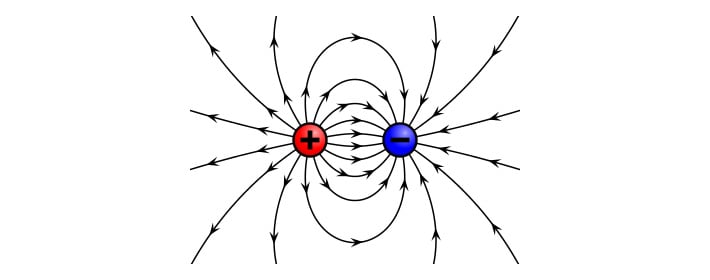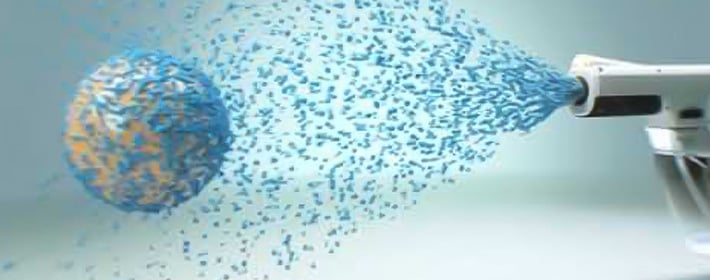How Do Electrostatic Sprayers Work?
The COVID-19 pandemic has turned new attention to disinfection processes. If you’ve heard any expert discuss disinfecting non-standard areas like fitness centers, restaurants or hospitals, you’ve probably heard them mention electrostatic spraying. But how do electrostatic sprayers work?
They're based on the principle that opposite electrical charges attract. If you take the “positive” end of a magnet and put it against the “negative” end of another magnet, they attract and stick. If you put the positive ends of two magnets together, however, they repel each other. An electrostatic sprayer is a device that electrically charges disinfectant, giving the solution a positive charge. Electrostatic sprayers use this principle to ensure fast, even coverage of the disinfecting agent.

The positively charged particles of the disinfectant in the sprayer seek out and cling to negatively charged, or grounded, surfaces (which is basically every surface in a hospital room, office, food service facility, etc). At the same time, those particles of the disinfecting solution repel each other. This means you’ll get safe, thorough coverage – without clumping or over-spraying. It also means you’ll be able to coat (and therefore disinfect) tight spaces and those areas that are out of your line of sight.
How Do Electrostatic Sprayers Work In Different Settings?
For instance, does an electrostatic sprayer work to disinfect the outside of a facility? Well, while you could use it outside, electrostatic disinfection is typically an inside job. Outdoor areas are notoriously porous, while electrostatic disinfection works best on hard, non-porous surfaces. If nothing else, however, you could use an electrostatic sprayer to disinfect hard surfaces outside, like a building facade or signage, treating large areas quickly and effectively.
As we’re all discovering the limits of manual disinfecting in our own homes, the natural next step is, “How do electrostatic sprayers work to disinfect residential homes or non-commercial buildings?” While electrostatic spraying has long enjoyed appeal in commercial spaces, there’s no real reason you can’t use them to keep your home disinfected, too. Quick and quiet, electrostatic sprayers can disinfect an entire residential home more thoroughly than manual sanitizing in a fraction of the time.

Disinfecting With An Electrostatic Sprayer
Electrostatic spray-cleaning is a 360-degree “no touch” process, but keep in mind that electrostatic spraying only kills germs that come in contact with the solution, and it does not remove surface grime. Surfaces should be wiped physically clean prior to disinfection.
The sprayer operator moves methodically through the area to be disinfected, making sure to coat all surfaces. This grid-like approach stands in sharp contrast to a manual cleaning process, when you need to prioritize high-traffic, high-touch areas, and often leave unseen or tight spaces still contaminated.
Using the Evaclean system of a Protexus sprayer with disinfecting PURTABS, you can coat all the surfaces of a 500 square foot area in less than 3 minutes. That’s an 80% time savings for any chemical application, disinfection, or sanitizing process. The Protexus sprayers are also very quiet (under 60 decibels), so you don’t have to worry that the disinfecting process (brief as it might be) will be disruptive to those within earshot.
The types of viruses and bacteria you’ll be able to neutralize with an electrostatic sprayer depends on the concentration of the solution you use. Zogics’ Protexus products are used with PURTABS, which are an effervescent sanitizing and disinfecting tablet. The tablets can be mixed easily in different PPM (parts per million) based on the need.
In the appropriate concentration, Zogics’ Protexus sprayers and PURTABS disinfectant can kill 99.99% of bacteria found in biofilm, C. Difficile, TB and other viral and fungal infections -- and all in only minutes. Choose the PPM that is right for your application. For example, when disinfecting food-contact surfaces, 100 PPM of PURTABS multi-purpose solution is sufficient. Hospital-grade disinfectant, on the other hand (which is used to kill cold and flu viruses, salmonella, and staph bacteria, among many others) requires 5 times that PPM, while killing certain bloodborne pathogens requires more than 1,000 PPM.
And yes, PURTABS solution kills COVID-19 – a solution of 1076PPM is recommended (that's one (3.3g) PURTABS tablet in 32 oz of water for the Protexus handheld sprayer, and eight (3.3g) PURTABS tablets or two (13.1g) tablets in two gallons of water for the backpack sprayer).
How Do Electrostatic Sprayers Work: Summary
An electrostatic sprayer electrically charges disinfectant, allowing it to evenly coat all types of surfaces for a more thorough disinfection. As the spray exits the nozzle, it’s given a positive electrical charge, which means it then becomes attracted to all negative surfaces, helping to cover uneven or challenging areas with the sanitizing agent. This technology has been around for more than 50 years, but only recently has gained favor in the cleaning and disinfecting industry.
We're proud to offer a range of reliable, effective electrostatic sprayer options to suit your needs. Consider our electrostatic sprayers today for your 360-degree, no-touch disinfection solution.
For Protexus and PURTAB usage guides by industry, and helpful information, check out the links below:
- Protexus PX200ES Handheld Sprayer Overview Brochure
- Protexus PX200ES Handheld Sprayer Safety Instructions
- Protexus Coronavirus Information Sheet
- EvaClean Protexus Usage Guide: Athletics Facilities
- EvaClean Protexus Usage Guide: Assisted Living Facilities
- EvaClean Protexus Usage Guide: Building Services
- EvaClean Protexus Usage Guide: Food Services
- EvaClean Protexus Usage Guide: Higher Education
- EvaClean Protexus Usage Guide: Education K–12
- EvaClean Protexus Usage Guide: Hospitality Facilities
- EvaClean Protexus Usage Guide: Laboratory & Clean Room
- EvaClean Protexus Usage Guide: Transportation Facilities
- EvaClean Protexus Usage Guide: Veterinary Services
Empower your staff and reassure your community with our FREE downloadable cleaning and disinfecting guides for fitness centers, educational settings, hospitality facilities and more.
Topics from this blog: #trending Product Resources
Back


